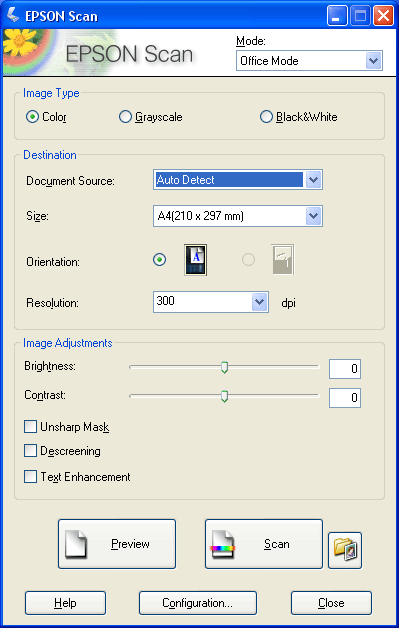 |
 |
|
||
 |
||||
Scanning Using the Automatic Document Feeder
When you scan documents with the ADF, it is best to use Office Mode.
 Note:
Note:|
Do not open the ADF while you are scanning or you will see an option error and paper feeding will stop.
Do not load mixed-size document pages when you are scanning only a portion of each page.
Office Mode and Professional Mode are available for scanning documents using the ADF.
|
 |
Make sure you installed the ADF and loaded your document in it. See Loading Documents in the Automatic Document Feeder for instructions.
|
 |
Start Epson Scan. See one of these sections for instructions.
|
 |
Click the arrow in the Mode box at the top right of the Epson Scan window. Then select Office Mode.
 |
You see the Office Mode window:


 |
Select whether the Image Type of your document pages is Color, Grayscale, or Black&White.
|
 |
Select Auto Detect, ADF, or Document Table as the Document Source setting.
|
 Note:
Note:|
If you loaded mixed-size sheets at one time, select Auto Detect instead.
|
 |
Select the size of your original document as the Size setting.
|
 |
Click the arrow next to the Resolution list and select the number of dots per inch at which you want to scan. See the table below for some guidelines:
|
|
What you will do with the scanned image
|
Suggested scan resolution
|
|
Send via e-mail, upload to web, view only on the screen
|
96 to 150 dpi
|
|
Print, convert to editable text (OCR)
|
300 dpi
|
|
Fax
|
200 dpi
|
 |
Click the Preview button toward the bottom of the Epson Scan window.
|
The ADF loads your first document page, then Epson Scan prescans it and displays it in the Preview window. The ADF then ejects your first page.
 |
Place your first page on top of the rest of the pages, then load the entire document into the ADF.
|
 |
In the Preview window, draw a marquee (a line marking the scan area) around the portion of your document page that you want to scan.
|
For instructions on creating and adjusting a marquee, see Adjusting the Scan Area (Marquee).
 |
Change any necessary Image Adjustments settings as listed in the table below.
|
|
Setting
|
Available mode(s) and description
|
|
Brightness
|
Adjusts the overall image lightness and darkness.
|
|
Contrast
|
Adjusts the difference between the light and dark areas of the overall image.
|
|
Unsharp Mask
|
Turn on to make the edges of image areas clearer for an overall sharper image. Turn off to leave softer edges.
|
|
Descreening
|
Removes the rippled pattern that can appear in subtly-shaded image areas, such as in skin tones. Also improves results when scanning magazine or newspaper images which include screening in their original print processes.
|
|
Text Enhancement
|
Enhances text recognition when scanning text documents.
|
|
Threshold
|
Adjusts the level at which the black areas in text and line art are delineated, improving text recognition in OCR programs. This setting is available only when the Image Type is set to Black&White.
|
 |
Click the Scan button to scan your document pages.
|
 |
What happens next depends on how you started your scan.
|
If you started your scan by running Epson Scan as a standalone program, you see the File Save Settings window. See Selecting File Save Settings for details.
If you started your scan from a scanning program such as ABBYY FineReader, your scanned pages open in the program window. Click Close to close the Epson Scan window and view your scanned pages in the program.
If you started your scan from Epson File Manager, you see thumbnails of your scanned images in the Epson File Manager window.
If you want to use your scanned images in one of the Epson Creativity Suite project programs, click the checkbox beneath each image thumbnail. The images are displayed in the My Selection box on the bottom of the Epson File Manager window.
Then select one of these project icons at the top of the window:
If you want to use your scanned images in one of the Epson Creativity Suite project programs, click the checkbox beneath each image thumbnail. The images are displayed in the My Selection box on the bottom of the Epson File Manager window.
Then select one of these project icons at the top of the window:
 Note:
Note:|
If you do not see your scanned images, select the folder in which you saved them on the left side of the Epson File Manager window.
|
|
Project icon
|
For instructions, see these sources
|
|
Scan and Copy
| |
|
Copy to Fax
|
See the Epson File Manager or Copy Utility Help for instructions.
|
|
Attach to e-mail
| |
|
Use Image
|
See the Epson File Manager or Image Clip Palette Help for instructions.
|